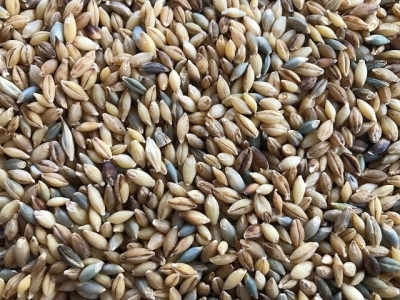New naked barley offers feed, food potential

A newly released naked barley strain may provide an alternative feed ingredient for organic poultry producers, says researcher.
A team from Oregon State University, Northwestern Washington Research and Extension Center and the US Department of Agriculture’s (USDA) Agricultural Research Service (ARS) have released a new strain of naked, or hull-less, barley that be use used for animal feed, brewing and human food.
Patrick Hayes, professor in the department of crop and soil science at Oregon State University, said that, internationally, barley has been a popular ingredient in animal feed but its use has dwindled in the US. However, the new strain of “naked barley” may have attract organic feed producers.
“It would simplify things for growers if the same kind of barley could be used in multiple ways – enter feed markets, be used in food and for brewing,” he told FeedNavigator. “We’re tracking how it could be used for those three applications.”
The research group was awarded a grant through the USDA’s NIFA organic research grant program to explore the potential for the barley to be used in several applications.
The barley strain is called 'Buck'in reference to its status as a naked grain. “The predecessor strain was [named] streaker."
'Buck' has been commercially released and seeds for are being planted this year, said Hayes.
“There’s often a lag in commercially available seed and the release itself,” he said. “There is production of certified classes of seed and there is some seed production in the ground, some foundation seed that will give rise to 40,000lb.”
Naked, not indecent, barley development
Work to develop the new strain of barley started with crosses made about 10 years ago, said Hayes. The development was done through crossbreeding rather than through use of trans-genic processes.
“There is a tendency to be a little more adventurous,” he said of organic production systems.
However, there would be no reason the grain couldn’t be grown on a non-organic farm, he added.
“In the plant breeding world we’re always trying to make better things,” he said. “Buck was started with a cross that we made 10-12 years ago, so we have new things in the [pipeline] that have different end uses.”
“The idea would be that with the Buck barley once it is out there in commercial varieties then there will be others,” he said.
The new varieties would be able to progress past the options offered by Buck, he added.
There were multiple goals with the development of the new feed and food grain, said Hayes. These include providing a new crop option to farmers in the US Pacific Northwest, furthering education and expanding research and knowledge.
The grain has been bred to be a winter crop that could manage the weather found in areas including the Pacific Northwest, parts of Minnesota, Wisconsin and northern New York, he said.
“Naked barleys do have a health claim – naked or pearled [barley] has been demonstrated to reduce the risk of heart disease,” he said. And it has been linked with an increased feeling of satiety, he added.
Barley offers a high level of soluble dietary fiber, even when the hull is removed in non-whole grain versions like pearled barley, he said. However, by providing a crop without the hull it cuts a level of processing that can be energy intensive and requires specialized equipment.
Upcoming research and feed trials
In the upcoming research project to assess the uses of the new barley strain, the group will be working with a poultry nutritionist, said Hayes.
“We’ve got a feed connection that we’d like to strength,” he said. “We have right now only one funded feed component in the program that is going to be using the naked barley for poultry nutrition layers and broilers.”
The project is set to examine the use of the barley as an ingredient in the diet for organically-raised poultry, he said. The feeding trial is set to start in the fall at Oregon State University.
“If a farmer is producing barley and the food market is saturated, and the malting and brewing market the protein is too high to go into them, the farmer has the opportunity to go into the feed industry,” he said of the new strain. “[It could] feed cattle, dairy and barley is used in swine nutrition in Canada.”
“One of the things that we’ve got to be cognizant of [for feed use] is the beta-glucan,” said Hayes. “That’s the soluble dietary fiber, the beta-glucan, so our approach to that is we’re going to be using barley that has modest levels and part of the trialing will be to see how the birds are producing.”
However, the group also is hoping to see the barley evaluated as a component in feed for organic dairy cows, he said. “The ruminant piece is one that would be based on the idea that the naked barley would be a starch and protein source and that there are other fiber [sources].”
The barley also is being assessed for its use in the brewing and malting processes, he said.
Related news
 Tiền Giang asks for enhanced protection for star apples brand exported to US
Tiền Giang asks for enhanced protection for star apples brand exported to US The southern province of Tiền Giang has proposed that the management overseeing the quality of star apples exported to the United States (US) be enhanced
 VN pepper industry about to burst
VN pepper industry about to burst Việt Nam’s pepper farmers are on pins and needles as pepper prices continue to decline. The industry, once known for its high profit margins
 Belgium boosts agricultural cooperation with Vietnam
Belgium boosts agricultural cooperation with Vietnam Belgian Federal Minister for Agriculture Denis Ducarme is on a visit to Vietnam to promote agricultural cooperation between the two countries